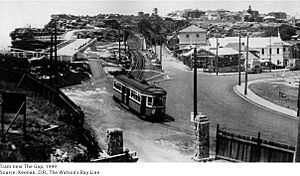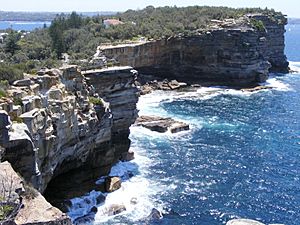The Gap (Sydney) facts for kids
The Gap is a famous ocean cliff in Sydney, New South Wales, Australia. It's located on the South Head peninsula in eastern Sydney, facing the Tasman Sea. You can find it in the suburb of Watsons Bay, near South Head.
Contents
History of The Gap

Before European settlers arrived, the Birrabirragal Aboriginal clan lived at The Gap. They were part of the coastal Darug people.
Soon after the First Fleet arrived in 1788, the British set up a simple signal station on the ridge above The Gap. This station helped warn the colony if any ships were coming. A proper signal station was built in 1790. A path to it later became the Old South Head Road by 1811. Pilots from Camp Cove in Watsons Bay would meet ships at the entrance to Port Jackson to guide them safely into Sydney Harbour.
The Gap as a Military Base
In 1871, the area around The Gap became a military base. Work began to build coastal artillery to protect the Port of Sydney. The colonial government's militia built these defenses. The first barracks for soldiers were finished by 1877. More buildings were added in 1880 for extra personnel. Many of these old barracks are still standing near The Gap today.
By 1895, the new Australian Army used the area as a gunnery school. In 1942, the Royal Australian Navy opened a radar training school nearby. This facility was later named HMAS Watson in 1945. Training for torpedoes and anti-submarine warfare moved to Watson in 1956. Sometimes, visitors can see the clifftop chapel. It was dedicated in 1962 to honor service members who worked at The Gap.
Since 1982, The Gap has been part of Sydney Harbour National Park. In 1990, the area was opened to the public. This allows everyone to enjoy the amazing cliff views and walking paths.
The Dunbar Shipwreck Story
In 1857, a sailing ship called the Dunbar crashed into the rocky cliff at the bottom of The Gap. The ship had 63 passengers and 59 crew members. The Dunbar left England on May 31, 1857. It arrived near Botany Bay after dark on August 20, 1857.
The weather was stormy, and it was hard to see. Captain James Green made a mistake judging the harbour entrance. The Dunbar hit the rocky cliff. Its top masts broke, and the ship turned sideways against the rocks due to the strong waves. The funeral for the Dunbar victims was one of the longest ever seen in Sydney. The people who couldn't be identified were buried in a shared grave.
Only one person survived the shipwreck: a young sailor named James Johnson. He held onto a rocky ledge below The Gap for 36 hours before being rescued. Johnson later worked at a lighthouse near Newcastle. He even rescued another lone survivor from a different shipwreck in 1866.
More than 50 years later, the Dunbar's anchor was found. It was placed on the cliffs at Watsons Bay with a special memorial plaque.
Rocks, Animals, and Plants at The Gap
The Gap is made from Sydney sandstone. This rock was formed from sediment over 200 million years ago, during the Triassic period. About 40 million years later, in the Jurassic era, a huge event caused a massive crack in the rock layers. This crack allowed wave action to wear away the rock, creating the cliff line we see around Sydney today.
At the bottom of the cliff, you can find flat, patterned basalt rock platforms. The rock at The Gap is very porous, meaning it has tiny holes. It's mostly made of pure silica grains. The warm yellow-brown color of The Gap comes from the rock oxidizing, which is like rusting.
Wildlife and Vegetation
You can often see Skinks and eastern water dragons moving among the rocks. Seabirds, like the silver gull and the Pacific gull, use the cliff as a place to build their nests.
The sandstone cliff creates soil that doesn't have many nutrients. Because nutrients are scarce, the plants that grow on The Gap protect their leaves with toxins. This stops animals from eating them. Eucalypts, for example, produce these kinds of toxins.
Gallery
-
The Gap looking out over Vaucluse and the Tasman Sea to the south





